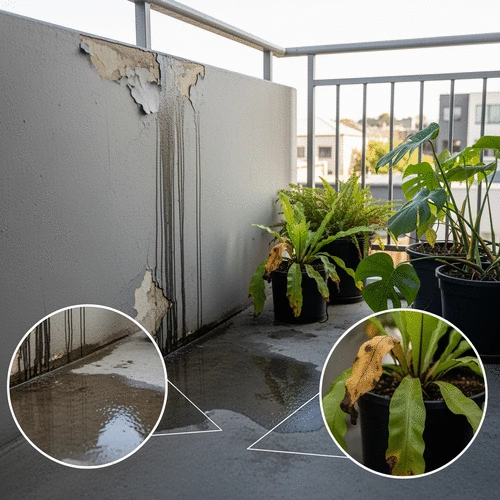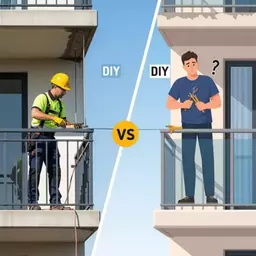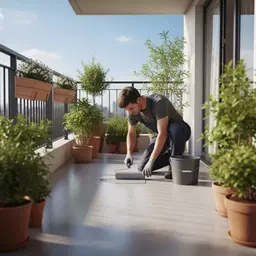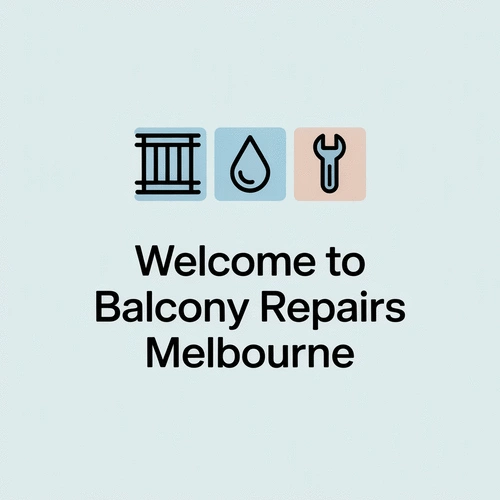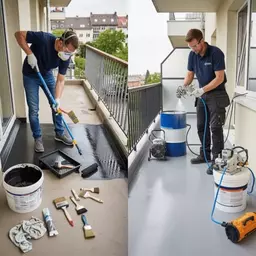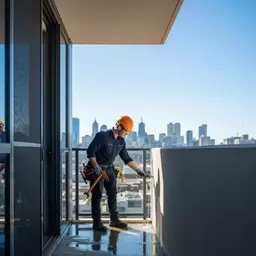As a homeowner in Melbourne, understanding the signs of balcony leaks can save you from expensive repairs. Recognizing these indicators early ensures the safety and integrity of your outdoor space, especially with the city's unpredictable climate.
What You Will Learn
- Early identification of balcony leak signs can prevent serious structural damage and costly repairs.
- Melbourne's unique climate can exacerbate balcony maintenance issues; regular inspections are crucial.
- Key indicators of leaks include water stains, cracked grout, and pooling water on balconies.
- Understanding local regulatory guidelines and insurance requirements will help ensure compliance and security for your repairs.
Key Balcony Leak Indicators & Regulatory Compliance
Understanding the signs of balcony leaks and the crucial role of regulatory guidelines in Melbourne.
Balcony Leak Indicators
-
•
Water Stains & Efflorescence: Discoloration, white powdery deposits.
-
•
Cracked Grout & Peeling Paint: Compromised waterproofing, moisture under surface.
-
•
Pooling Water & Structural Damage: Inadequate drainage, sagging/instability.
-
•
Moisture Intrusion Effects: Wood rot, weakened concrete, rust.
Regulatory & Insurance Concerns
-
•
VBA Guidelines: Regular inspections, documented maintenance, qualified professionals.
-
•
Insurance Claims: Document damage, gather records, report promptly, follow up.
-
•
Building Codes: Load bearing, guardrails, waterproofing standards.
Understanding Balcony Leak Signs in Melbourne Homes
As a homeowner in Melbourne, you might not think about your balcony until a problem arises. Identifying balcony leak signs early is crucial for maintaining the safety and integrity of your outdoor space. A small issue can lead to bigger repairs down the line, not to mention the potential hazards posed by water damage. In this section, let's explore why it's essential to be on the lookout for these signs and the unique climate challenges our lovely city presents.
Why It’s Important to Identify Balcony Leak Signs Early
Recognizing balcony leak signs early can save you a lot of time and money. Water intrusion can cause serious structural damage over time, which may not be immediately visible. Early detection allows for timely repairs, helping you avoid more extensive—and expensive—work.
- Preventing mold and mildew growth, which can pose health risks.
- Maintaining the aesthetic appeal of your property.
- Ensuring compliance with local safety regulations.
From my experience in balcony restoration, I can assure you that taking a proactive approach is always better than waiting until you can see significant damage. Your balcony deserves attention before minor issues become major headaches!
The Unique Challenges of Melbourne's Climate on Balconies
Melbourne's weather is notoriously unpredictable, with sudden rain showers and extended periods of sun. This fluctuation creates unique challenges for balcony maintenance. Balconies can be subjected to heavy rainfall, causing water to pool if drainage systems are insufficient. Additionally, the sun can dry out sealants and materials, making them more prone to cracking and failure. For a deeper understanding of water leakage in balconies, the HIA provides valuable insights into investigating water leakage in apartment building concrete balconies.
- Frequent temperature changes can weaken structural integrity.
- High humidity levels can increase moisture retention in materials.
- Wind can exacerbate wear on railings and surfaces.
Understanding how Melbourne's climate impacts your balcony can help you take preventative measures. Regular inspections and prompt repairs will keep your space safe and functional.
Key Indicators of Balcony Leaks
Knowing the key indicators of balcony leaks is your first line of defense. Some signs can be subtle, while others are quite apparent. In the sections below, we will dive into common indicators that you should keep an eye out for.
Recognizing Water Stains and Efflorescence on Your Balcony
Water stains are often the first visual signs that something isn't right. You might notice dark patches on the surface of your balcony or walls. Efflorescence, which appears as white, powdery deposits, can also indicate moisture issues. These stains suggest that water has been seeping through the materials, and it’s time to investigate.
- Look for discoloration on surfaces.
- Check for any signs of mold or mildew.
- Inspect for bubbling or peeling paint.
As a balcony repair expert, I emphasize the importance of addressing these signs quickly. Ignoring them can lead to more severe issues down the road!
Identifying Cracked Grout and Peeling Paint as Warning Signs
Cracked grout is often a precursor to water damage. If you see cracks, it’s a good indication that the waterproofing might be compromised. Peeling paint is another sign that moisture is getting beneath the surface. Both of these signs should prompt you to take a closer look.
- Note any visible cracks or gaps in tiling.
- Inspect paint for any signs of blistering or flaking.
- Ensure that grout lines are intact and not crumbling away.
Addressing these issues sooner rather than later will ensure your balcony remains a safe and enjoyable space!
Detecting Pooling Water and Structural Damage on Balconies
Pooling water on your balcony is a clear sign that drainage is inadequate. This situation can lead to serious structural damage if left unattended. Structural damage might manifest as sagging or instability in your balcony. If you notice these signs, it’s crucial to take immediate action.
- Observe areas where water collects after rain.
- Look for sagging or uneven surfaces.
- Check railings and supports for any signs of weakness.
Timely action can prevent extensive damage, and that’s where my team at Balcony Repairs Melbourne steps in to help!
Understanding Moisture Intrusion and Its Effects on Balcony Integrity
Moisture intrusion is a serious issue that can compromise the integrity of your balcony. It can lead to wood rot, weakened concrete, and even rust on metal elements. For valuable information on preventing leaks, especially in apartment buildings, the BC Housing Maintenance Matters series offers excellent guidance on preventing leaks. Understanding moisture intrusion is key to maintaining your balcony's safety and longevity.
- Regularly inspect for signs of dampness.
- Check for musty odors, which can indicate hidden moisture.
- Look for signs of rust or corrosion on metal parts.
By being vigilant and proactive, you can ensure your balcony remains a safe and beautiful extension of your home!
Pro Tip
Did you know? Regular maintenance checks can significantly extend the life of your balcony? Aim to inspect your balcony at least twice a year, focusing on key areas like drainage systems and sealants. Catching minor issues early can save you from costly repairs down the line!
Addressing Regulatory and Insurance Concerns
When it comes to balcony maintenance, navigating the regulatory landscape can feel daunting. However, understanding the guidelines set forth by the Victorian Building Authority (VBA) is vital for ensuring safety and compliance. Whether you're a homeowner or a property manager, familiarizing yourself with these regulations not only helps avoid legal pitfalls but also enhances the longevity of your balcony.
Moreover, being aware of insurance requirements related to balcony repairs can save you from unexpected expenses. As we delve deeper into regulatory concerns, let's explore how these factors play a crucial role in balcony maintenance.
Navigating VBA Guidelines for Balcony Maintenance
The Victorian Building Authority provides a framework that governs how balcony maintenance should be conducted. It's essential to understand these guidelines to ensure compliance and safety. Here are the key points to consider:
- Regular Inspections: Conducting routine inspections is crucial to identify wear and tear.
- Documented Maintenance: Keeping records of maintenance works can help in compliance and future claims.
- Qualified Professionals: Always hire certified experts for repairs and maintenance to adhere to VBA standards.
By following these guidelines, you not only comply with local regulations but also promote a safe environment for everyone using the balcony. Remember, proactive maintenance can make a significant difference in the longevity of your outdoor space! You can find more details on the VBA's investigation of water leakage in residential apartment concrete balconies on their official website.
How to Handle Insurance Claims for Balcony Leaks
Dealing with insurance claims can be a complex process, especially when it comes to leaks. First, it's important to document the extent of the damage thoroughly. Here’s a quick checklist to help you navigate the claims process:
- Take clear photos of the leak and any resulting damage.
- Gather all relevant maintenance records.
- Report the issue to your insurance provider as soon as possible.
- Follow up on your claim to ensure timely processing.
Remember, being thorough and organized can expedite the claims process significantly. If you find yourself stuck, don’t hesitate to reach out to professionals at Balcony Repairs Melbourne who can assist you in making sense of the claims process and help with necessary repairs.
Understanding Building Codes Related to Balcony Safety
Building codes are the backbone of safety regulations for balconies. They ensure that structures are built to withstand various environmental factors, especially in a city like Melbourne where the weather can be unpredictable. Key aspects of these codes include:
- Load Bearing Requirements: Ensuring your balcony can support the weight of occupants and furniture.
- Guardrails: Compliance with height and strength specifications to prevent falls.
- Waterproofing Standards: Proper measures must be taken to prevent water intrusion and subsequent damage.
Understanding and adhering to these codes is not just about following rules; it’s about ensuring the safety of your family and guests. If you're unsure whether your balcony meets current standards, consider consulting with a structural engineer or a professional from Balcony Repairs Melbourne.
Frequently Asked Questions About Balcony Leaks
Q: What are the early signs of a balcony leak?
A: Early signs include water stains, efflorescence (white powdery deposits), cracked grout, peeling paint, and pooling water after rain. Musty odors can also indicate hidden moisture.
Q: How does Melbourne's climate affect balcony maintenance?
A: Melbourne's unpredictable weather, with sudden rain and prolonged sun exposure, can cause materials to weaken, leading to cracked sealants, compromised drainage, and increased wear on surfaces and railings.
Q: What is efflorescence and why is it a concern?
A: Efflorescence is a white, powdery deposit that appears on surfaces due to water seeping through materials. It indicates moisture intrusion and can be an early warning sign of a balcony leak.
Q: Why is early detection of balcony leaks important?
A: Early detection prevents serious structural damage, costly repairs, mold growth, and helps maintain the aesthetic appeal and safety of your property, ensuring compliance with local regulations.
Q: What are the VBA guidelines for balcony maintenance?
A: The Victorian Building Authority (VBA) guidelines emphasize regular inspections, documented maintenance records, and hiring qualified professionals for repairs and upkeep to ensure compliance and safety.
Recap of Key Points
Here is a quick recap of the important points discussed in the article:
- Early identification of balcony leak signs can prevent costly repairs and maintain safety.
- Melbourne's unpredictable climate can lead to unique challenges in balcony maintenance, including water pooling and material degradation.
- Key indicators of leaks include water stains, cracked grout, peeling paint, pooling water, and signs of moisture intrusion.
- Regular inspections and prompt repairs are crucial to maintaining the integrity of your balcony.
- Familiarity with local regulations and insurance requirements is essential for compliance and safety.
- Engaging with qualified professionals for balcony repairs ensures adherence to safety standards and enhances longevity.

